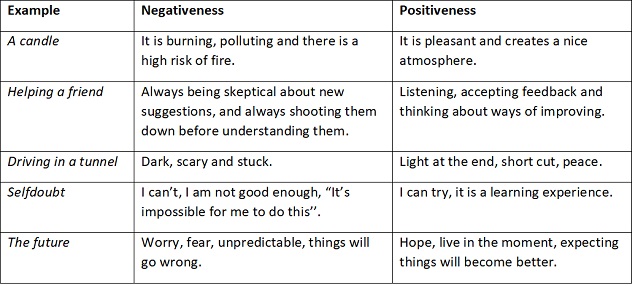 A Coaching Power Tool Created by Fadwa Badalla
A Coaching Power Tool Created by Fadwa Badalla
(Executive Coach, DENMARK)

I wouldn’t say ‘most’ people are prone to negativity. I think it’s probably that most people allow negativity to color their thinking, depending on circumstances, but I also believe most people make the necessary efforts to return to positive thinking as quickly as possible. – Zig Ziglar.
Introduction
Everybody’s lives are full of positive and negative experiences. But positiveness and negativeness can also be the state of mind – ways of thinking that can shape peoples’ lives for the better or the worse. Too much of either can be considered abnormal and in some cases lead to physical or psychological health problems. The role of coaching is substantial in helping clients discover their state of mind, what is causing it, embracing it and what and how to change behavior going forward.
The concepts and balance of positiveness & negativeness
According to Cambridge Dictionary, the definition positiveness is “the fact of being full of hope and confidence, or of giving cause for hope and confidence”. Negativeness is “an attitude that is not hopeful or enthusiastic” [1].
The concept exists both as adjectives (a positive or negative feeling/thought), or as a noun (positiveness/negativeness). What is common across these two concepts is the notion of how to look at the present and how the person is looking at the future. The person full of positiveness has a lot of hope for the future while the person with negativeness has lost hope for the future. But to form an opinion of the future you need to understand the past.
The concepts appear in many disciplines with different viewpoints:
We all experience these ways of thinking, and the end goal is to find the right balance between the two forces. Most people tend to lean towards negativeness more (a negative bias), which means the first thought that enters their mind about a present or future situation has a negative spin. Examples of this are:

Clients challenges – A personal example
I have experienced the struggle of balancing negativeness and positiveness myself.
I looked upon my upcoming round birthday with a great deal of negativeness. Fear about the future, fear of aging, of outside expectations around a certain age. It filled me with the feeling that this event should not be celebrated. I identified that particular event as a horrible one.
The consequences were unhappiness, isolation, lack of energy, and sadness. Over the years that feeling grew more and more. My first coaching session turned this development around. The session made me look at some different aspects which I had not thought of before, e.g., when the coach asked me few powerful questions, I had so many “aha” moments to where all these horrible aspects of my birthday started. It made me realize that it came from my expectations as a kid to achieve certain things at a certain age which limited my thinking. As a kid, I drew a future picture and carried it around while growing, not perceiving the expectation was hidden. However, at the coaching session, I gained so much self-awareness and knowledge about where all this started and what caused the way I felt about my birthday.
Since that moment I have shifted my perspective completely, I have chosen to replace my negativeness with positiveness by celebrating my birthday every year and enjoy my growth which made me who I am today. It was a memorable session that made a huge difference in my life and confirmed how coaching is so powerful.
This is symptomatic of what happens to people with a growing negativeness inside of them which is not counterbalanced with positiveness within themselves and discovered by themselves.
Coaching is an approach for addressing the challenges
This coaching approach to balancing negativeness and positiveness builds on four fundamental coachingtechniques:1) Building self-awareness, 2) Embracing the reality, 3) Shifting the client’s perspectives, 4) Achieving the balance between negativeness/positiveness
Building self-awareness
The client will gain self-awareness, meaning understanding what is triggering negative and positive thoughts and underlying attitudes and experiences driving. The coach will facilitate the process of self-discovery via questions to explore the circumstances and make the client identify key relationships and causes. Key questions include:
Embracing the reality
When you identify where your feelings are coming from, your inner self starts to gain self-awareness. The key elements are to embrace negativeness, to accept it, and to be conscious about it. The ability to allow what you want to accept opens new choices and new challenges in your life. ‘’Acceptance asks only that you embrace what’s true’’ Cheryl strayed. Key questions:
Shifting the client’s perspectives
This about making the client realize that he/she can influence the stream of negative or positiveness thoughts. By reversing any negativity with positivity the client’s overall perspective on the situation will change. Whenever any negative thought will come out, whenever there is a situation and you feel this overwhelming feeling. Practicing to replace negativeness with positiveness assures a positive outcome.
Key questions:
Achieving a balance between negativeness/positiveness
Self-awareness and willingness to shift perspectives are prerequisites for change for a client but do not necessarily trigger real adaptability towards a better negativeness/positiveness balance. The coach will work with the client to explore both “extreme” feelings more and then have the client define his/her own goals. This is an invitation to think of situations where the client was more positive, how it felt at that time, and using that as a starting point for how he/she wants it to feel in the future. The client can come up with own ideas to replace negative thoughts with positive ones and be proud of the gratitude it brings.
Key questions:
References:
[1] https://www.merriam-webster.com/dictionary/positive
[2] https://jamesclear.com/positive-thinking
[3] https://archive.coachcampus.com/coach-portfolios/power-tools/tim-jordan-negative-outlook-vs-positiveness/